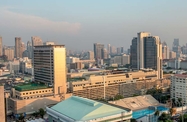News regarding Thailand was dominated during 2011 by political change and environmental catastrophe, with both having important economic impacts. For most of the year however, the country’s investment story was one of growing foreign interest on the back of steady economic growth.
Politically, a relatively smooth democratic transition process ushered in a new government, with the Pheu Thai party, led by Prime Minister Yingluck Shinawatra, claiming a clear victory in the July general election.
This stability belied some commentators’ fears that political change still posed the principle risk to the economy. Indeed, in terms of risk, 2011’s real challenges were brought by a string of natural disasters, not man-made ones.
In March, the devastating earthquake and tsunami that hit Japan, one of Thailand’s primary trading partners, temporarily disrupted the supply chains of many Japanese-owned manufacturers operating in Thailand.
Then, flooding on a scale not seen in 70 years, beginning during the spring and summer monsoon seasons and continuing to spread, killed approximately 675 people and put thousands of factories out of commission.
Prior to the deluge, however, things had been looking up. Despite the effect of the Japanese tsunami – GDP growth slowed from 3.2% in the first quarter of 2011 to 2.6% in the second quarter – the economy enjoyed a promising first half of 2011, with rising exports, GDP and foreign direct investment. Although not expected to match the 7.8% GDP growth seen in 2010, GDP in 2011 had been forecast to increase by 3.5-5%. Foreign investment was also well up, with more than $6.6bn entering the economy by June. Foreign trade looked positive too, with exports of $93bn by mid-year, an increase of 20.8% over the same period in 2010.
The floods changed all that, however. In late December the fiscal policy office said Thailand’s economy was expected to contract 3.7% in the fourth quarter of 2011 and cut its forecast for 2011 growth to 1%. The cost of flood damage is widely estimated to reach BT400bn ($13bn).
The floods also hit some industries harder than others. In the first half of 2011, up to 45% of the world’s hard disk drives (HDDs) were manufactured in Thailand, which is also a production hub for carmakers and electronics firms. These industries unfortunately bore the brunt of the flood, although producers were unevenly affected. Honda Motor Corporation and Pioneer Corporation, for example, were among those to have scrapped profit forecasts after the inundation rendered factories idle.
October thus saw industrial output tumble and on November 28, the industrial production index fell 35.8% year-on-year, according to the Office of Industrial Economics.
Auto production meanwhile declined 61.3%, HDD production fell 52.4% and manufacturing of electronics parts was down 45.5% over the same period. On November 22, the Commerce Ministry said shipments might contract 15% in the fourth quarter of 2011 as industrial estates prepared to resume operations.
The flooding had a slightly dampening effect on tourism too, with estimates putting damage and losses at around $333m. In March, foreign arrivals had been forecast to top 17m in 2011. At the end of the third quarter of 2011, international arrivals totalled 14.4m – still up 27% from 11.3m for the same time in 2010. At the time of writing, the overall effect of flooding on the tourism industry had not yet been calculated.
Thailand’s construction sector had been expected to see solid growth of around 4% in 2011, according to data from the NESDB, partially on the back of campaign pledges to increase low-cost housing availability. However, many construction firms are concerned the raising of the minimum wage to BT300 ($9.73) per day from the previous average of BT190 ($6.15) could add 6% to the cost of building projects. Pheu Thai has said it will reduce corporate income tax from 30% to 23% to counter higher wage bills.
Nonetheless, it seems construction may well benefit from the floods’ only silver lining – the growth expected come from reconstruction. Thailand’s finance ministry expects GDP to expand 5% in 2012 as the government spends to rebuild damaged areas. Prime Minister Shinawatra has proposed spending BT130bn ($4.2bn) on rebuilding.
Thailand’s economic situation should therefore begin a return to normal in the first quarter of 2012, boosted by reconstruction spending, government policies to increase income and private investment in the form of machinery equipment. Indeed, the NESDB expects a return to normal growth in the second quarter of 2012, as manufacturing resumes.

